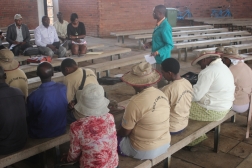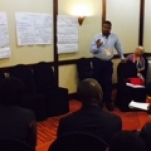You are here
Improving Access to Services for Children and Families Through Collaboration Among Health Workers and Social Service Workers

When health workers and social service workers collaborate to enhance community capacity to care for children and adolescents, vulnerable children and families reap the benefits. Last month, I witnessed first-hand some of those benefits.
Global evidence shows that children orphaned by AIDS or living with HIV-positive caregivers face an increased risk of physical and emotional abuse as compared to other children in sub-Saharan Africa, including other orphans. They also face stigma, neglect and many other issues that negatively impact their psychosocial wellbeing.
To strengthen linkages and referral systems between community and government service providers, the Bantwana Initiative was developed by World Education Initiative (WEI) and is an initiative of WEI and John Snow, Inc. The program prides itself on “innovative models of care that are based on existing community structures and address children’s comprehensive needs.” The program is supporting vulnerable children and families in Swaziland, Tanzania, Uganda, and in Zimbabwe, which I recently visited.
In Zimbabwe, nearly one in four children has lost one or both parents, most due to HIV/AIDS, and 1 in 11 children die before age five due to HIV-related illnesses.[1] Additionally, there were an estimated 1.2 million Zimbabweans living with HIV/AIDS in 2011, 200,615 were children under age 15.[2] Many of these children acquired HIV from their HIV-infected mothers during pregnancy, birth, or breastfeeding, with mother-to-child transmission accounting for virtually all new HIV infections among infants in Zimbabwe. There are also a total of 1.2 million children of school going age, between 3-16 years, who were out of school in 2012 and 843,266 people (ages 5-24 years) had never been to school[3]. Overall, more than one quarter of children between 3 to 16 years were out of school. To combat these staggering statistics, Bantwana developed an integrated pediatric HIV/AIDS care and treatment program and is working closely with the government to strengthen the social service system.
I had the opportunity to meet Shelton Tshuna, one of the 9,765 community-level child care workers trained across 65 districts throughout Zimbabwe. The neighborhood where he works is familiar and convenient to him because it’s in his backyard. We drove less than 10 minutes from the tourist town of Victoria Falls to his community in the Chinotimba area. Only an SUV would be able to travel the paths of this village, for when we stepped out of the car, golden dust half covered our shoes.
 I attended a meeting of 21 child care workers (CCWs) as they discussed some of the issues facing their community and how they can best address them. They’re easily recognizable, as each wears a t-shirt and hat that announce them as a child care worker within the community. They’ve received training to be sensitive to the needs of children living with HIV, case management procedures, and some psychosocial support. They’ve also attended a course on basic counselling and communication, receiving a certificate upon completion. The CCWs have come to gain the trust of their neighbors and are viewed as a formal role within the community, leading to community participation in identifying children in need of the CCW’s help. The CCWs work with the Child Protection Committee and Village Health Worker to implement an integrated approach to addressing the children's overall well-being.
I attended a meeting of 21 child care workers (CCWs) as they discussed some of the issues facing their community and how they can best address them. They’re easily recognizable, as each wears a t-shirt and hat that announce them as a child care worker within the community. They’ve received training to be sensitive to the needs of children living with HIV, case management procedures, and some psychosocial support. They’ve also attended a course on basic counselling and communication, receiving a certificate upon completion. The CCWs have come to gain the trust of their neighbors and are viewed as a formal role within the community, leading to community participation in identifying children in need of the CCW’s help. The CCWs work with the Child Protection Committee and Village Health Worker to implement an integrated approach to addressing the children's overall well-being.
“Working with the community is important,” Shelton told me. As a CCW for the last 1.5 years, he’s spent months getting to know 13-year-old Khethiwe* and gaining the trust of his grandfather. The boy moved from another area of Zimbabwe last year after his mother, father and younger brother all died from HIV. His grandfather and a maternal aunt are now his caregivers. Out-of-school for a period, Shelton helped Khethiwe re-enroll in school. He told me that social studies is his favorite class. He’s also begun making new friends. In fact, he was playing soccer with them when we arrived. The transition hasn’t been easy, though. Shelton visits Khethiwe and his caregivers frequently, which is apparent from their casual, friendly interaction.
Prior to Shelton’s help, the grandfather told me their “situation was pathetic, and we couldn’t afford much.” Shelton is helping enroll the family in World Vision’s food program, to ensure Khethiwe receives adequate, nutritious meals to help with his own HIV status. He’s also now receiving ARV treatments and paperwork is underway to obtain his birth certificate, which will help the family to access additional benefits and services from the government and volunteer organizations.
Bantwana is also collaborating with UNICEF and Zimbabwe’s Department of Social Services (DSS) on a three-year case management project. As part of the scale-up, CCWs receive training to work with vulnerable children until they no longer need their services. Through the program, DSS social work staff will be deployed to 30,000 vulnerable households by 2017, Yvonne Mandikutse, a child welfare officer with the government told me.
To-date, the program is having great results, some of these I witnessed first-hand. In Shelton’s ward, in the last year, community members have increased their sensitization to neglect and sexual abuse, leading to increased reporting of these issues; two children were reunited with their families; 34 students were re-enrolled in school; and CCWs helped 34 children/families to obtain birth certificates, necessary to help the families qualify for additional aid and support.
“How to handle children in distress is critical to training of para professionals. We’ve trained close to 1,500 para social workers. Strengthening of formal and informal systems to increase the wellbeing of children begins at the community level,” said Edton Babu Ndyabahika, Deputy Country Director, Bantwana Initiative, Uganda.
The need for more and better integrated services is beginning to receive more attention. I joined more than 400 attendees from 27 countries, largely within sub-Saharan Africa, at the Regional Psychosocial Support Initiative Forum (REPSSI Forum) in Zimbabwe for three days in September to discuss the importance and challenges of integrating child protection, HIV programming and psychosocial support by strengthening community level linkages. There, I met Edton and several others from Bantwana’s other country programs, who all shared examples of why this is important and how it’s making a difference in their countries.
“Strengthening the framework of psychosocial support must remain embedded in social services. Exposure to best practices and the exchange of knowledge adds quality to psychosocial support,” said Priscah Mupfumira, Minister of Public Service, Labour and Social Welfare, Zimbabwe, in her address to Forum attendees.
Initiatives like Bantwana in Zimbabwe are making this case on the ground, effectively integrating a case management model into existing government social services and extending the government’s reach to the children and families who need support most.
 As a co-sponsor of the REPSSI Forum, the Global Social Service Workforce Alliance, the organization where I work, held three sessions on the importance of supporting community-level workers (or para professional workers), including increased training and recognition, so that they can be best utilized toward strengthening these community linkages. Community-level workers play critical roles in linking programs to health facilities, reinforcing promising practices, uniting organizations and government, and promoting a referral system. Largely community volunteers, these workers oftentimes lack the training and recognition to work hand-in-hand with health workers and others providing and advocating for children’s well-being. To help address these gaps, the Alliance’s Interest Group on Para Professionals, comprised of dedicated members of the Alliance, developed a competency framework. This new resource outlines functions and competencies of para professional social service workers. It is our hope it will be used to provide program guidance, accountability and ultimately inform training and supervision of para professionals.
As a co-sponsor of the REPSSI Forum, the Global Social Service Workforce Alliance, the organization where I work, held three sessions on the importance of supporting community-level workers (or para professional workers), including increased training and recognition, so that they can be best utilized toward strengthening these community linkages. Community-level workers play critical roles in linking programs to health facilities, reinforcing promising practices, uniting organizations and government, and promoting a referral system. Largely community volunteers, these workers oftentimes lack the training and recognition to work hand-in-hand with health workers and others providing and advocating for children’s well-being. To help address these gaps, the Alliance’s Interest Group on Para Professionals, comprised of dedicated members of the Alliance, developed a competency framework. This new resource outlines functions and competencies of para professional social service workers. It is our hope it will be used to provide program guidance, accountability and ultimately inform training and supervision of para professionals.
It takes a strong social service workforce to provide the best care for vulnerable populations. The Alliance celebrates people like Shelton who are committed to making this dream a reality and supports these linkages through conferences, tools and resources.
_____________________________________________________________________
*Child's name has been changed to protect his identity.
_____________________________________________________________________
[1] The National Strategic Plan for Eliminating New HIV Infections in Children and Keeping Mothers and Families Alive (2011-2015)
[2] MOHCW AIDS & TB Unit Annual Report 2011
[3] UNICEF Commissioned a 'National Assessment of Out of School Children,' Dr Jeanette Manjengwa, June 2015
_____________________________________________________________________
Additional resource:
Protection and resilience: A simple checklist for why, where and how to coordinate HIV and child protection policy and programming, introduced at the REPSSI Forum during a session presented by OVCSupport.net.
